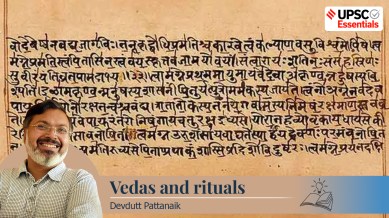Art and Culture with Devdutt Pattanaik | The significance of Vedas and their rituals
The three primary Vedas - Rig Veda, Sama Veda and Yajur Veda - were part of public rituals. Why was the Atharva Veda neither seen as part of the primary Vedic canon nor as part of public rituals?

(The Indian Express has launched a new series of articles for UPSC aspirants written by seasoned writers and erudite scholars on issues and concepts spanning History, Polity, International Relations, Art, Culture and Heritage, Environment, Geography, Science and Technology, and so on. Read and reflect with subject experts and boost your chance of cracking the much-coveted UPSC CSE. In the following article, Devdutt Pattanaik, a renowned writer who specialises in mythology and culture, explains Vedic poetry, Vedic prose, and Vedic philosophy.)
When we talk about the Veda, we have to differentiate between Vedic poetry, Vedic prose, and Vedic philosophy. Vedic poetry is the oldest part of the Veda, which is over 3,000 years old. Vedic prose came later and was followed by Vedic philosophy. They were transmitted orally by Brahmin families and put down in writing less than 2,000 years ago.
Vedic poetry, or mantra, exists as collections or Samhitas. The Rig Samhitas are the oldest collection of Vedic poetry. There are about 1,000 poems divided into 10 books or mandalas. Ninety percent of these are invocations to gods who live in the sky, invited to a meal in exchange for which the host asks for success in worldly matters, such as having children, health, victory in battle and so forth. Ten percent are linked to various kinds of philosophies and speculations about the world.
monthly limit of free stories.
with an Express account.
Vedas and rituals
A portion of the Rig Vedic poetry becomes part of the Sama Veda, where words of the Rig Veda are turned into melodies. The melodies are of two types: the first is sung in the settlement called the Grama Gan, and the second is sung in the forest known as the Aranya Gan.
The Yajur Veda also contains many Rig Vedic poems. Additionally, it has a few original ones too. But these poems are specifically linked to performing rituals. There are special poems or mantras, known as yajus, which are meant to be said when performing certain ritual actions.
The Rig Veda can be said to be the lyrics, Sama Veda the music, and Yajur Veda the instructions, all three of which form the Trayi or the primary Vedas.
In many scriptures, it is these three that are considered the Veda. They were part of public rituals.
The Atharva Veda is also a set of poems, but these were primarily spells used for domestic matters such as health, good fortune, and to ward off malevolent spirits and people’s jealousy and anger. There are some speculative hymns here too, but generally, the Atharva Veda was not seen as part of the primary Vedic canon. They were not part of public rituals.
Brahmanas and Aranyakas
Rig Veda was compiled in the Haryana region. The other Vedas were composed in the Ganga-Yamuna basin east of the river Gandak. While Rig Veda refers to a nomadic pastoral people, the Yajur Veda refers to a people establishing farms and living a settled life, moving eastwards.
Over time, prose started being written. These were known as the Brahmanas and Aranyakas, which were meant to perform large congregational ceremonial rituals related to kingship. Aryanakas (forest texts) are for rituals performed outside the village. Brahmanas are prose texts of rituals.
The rituals were performed fortnightly on full moon days and new moon days, or they were performed every four months to mark the end of the pre-monsoon period, the monsoon period, and the post-monsoon period. They were also related to the king’s coronation and annual rituals to increase the king’s power.
These were gradually documented in the Sulba Sutras. However, these started losing value after 500 BCE when Buddhism arose in the eastern part of India. After this period, we find mostly domestic Vedic rituals becoming important, and these were documented in the Grihya Sutras. Another set of prose that emerged around this time was the Shastra literature, such as the Dharmashastras.
Vedic philosophy
After 500 AD, we find both Vedic poetry and Vedic prose losing their value and a gradual rise in Vedic philosophy, which is traced to the Upanishads. Seen from the present lens, we know that there were different Vedic schools across India. Each one focused on one poetry book, either the Rig Veda, Sama Veda, or the Yajur Veda. Each of these has a prose text and a philosophy or Upanishads.
But today, when people talk about the Vedas, they refer to Vedic philosophy or Vedanta. These became popular after 500 AD, especially after 800 AD, thanks to Adi Shankaracharya and those who followed him. In Vedic philosophy, ritualism is downplayed and more importance is given to philosophical ideas like Atma and its relationship with the human body and the world around us. These are concepts like moksha or liberation.
The ritual school or Mimamsa school eventually merged with temple practices. Even today, when people refer to the word Veda, they really refer to Vedic philosophy and very little to Vedic poetry, Vedic chanting, and Vedic rituals.
Post Read Question
Discuss the essence of the Vedas?
What are the salient features of the Vedic period?
Comment on the significance of Vedic rituals in Hinduism.
What is the difference between the Vedas and the Vedic philosophy?
(Devdutt Pattanaik is a renowned mythologist who writes on art, culture and heritage.)
Subscribe to our UPSC newsletter and stay updated with the news cues from the past week.
The UPSC articles of Indian Express is now on Telegram. Join our Telegram channel- Indian Express UPSC Hub and stay updated with the latest Updates.
Share your thoughts and ideas on UPSC Special articles with ashiya.parveen@indianexpress.com.
https://www.youtube.com/watch?v=nC4ckaj-dJI?si=HiDRY3KyDJMEoY0v&w=560&h=315